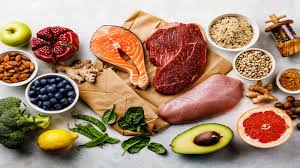 Proteins are synthesized from amino acids and are the major structural and functional components of the body.
Proteins are synthesized from amino acids and are the major structural and functional components of the body.
Nine of the 20 amino acids found in human proteins are indispensable – omitting any of them from the diet leads to physical signs and a negative whole body protein balance.
Six of the amino acids are conditionally indispensable, meaning sufficient amounts cannot be synthesize when there are periods of rapid growth and severe metabolic stress.
Protein requirements are estimated with the use of nitrogen balance methodology: monitor of nitrogen losses in feces, urine, and skin, according to variations in protein intake.
Five amino acids are dispensable, meaning, non-essential, and can be synthesized in vivo to meet the needs of the body.
Proteins are in a dynamic state of continual turnover, requiring replacement, sure the diet to maintain most body functions and health.
Animal sources of proteins, contain all nine indispensable amino acids, whereas plant proteins are deficient usually in one or more indispensable amino acids.
After ingestion of protein the peripheral glucose concentration does not increase in healthy individuals or in patients with type II diabetes.
Diets rich in protein, especially plant protein, lower blood pressure and reduce cardiovascular risk.
Increased protein intake from mixed sources has favorable effects on lipids.
With an inadequate intake of total proteins or any indispensable amino acid leads to adaptations in protein metabolism that can impair infant brain development, immune compedence and other physiological and metabolic functions.
Inadequate intake of energy from the fat and carbohydrates can lead to a negative nitrogen balance.
Excess amino acids that are present during periods of high protein intake can be delaminated to form, alpha keto acids, which then can be oxidized for energy or converted to glucose or fat.
When people overeat a diet either high or low in protein, they become less metabolically efficient than diets of average protein intake (Stock MJ et al).
A digestible amino acid score is used to grade protein sources.
Cow’s milk, beef and eggs, have the highest score at a value of approximately one; rice has a value of approximately 0.5; soy protein has a score of approximately 0.9 and is a beneficial plant source of amino acids.
Vegan and vegetarian can maintain adequate high protein intake by eating a variety of plant-based foods, including: legumes, greens, soy products, nuts, and seeds.
The greatest metabolic efficiency of weight gain during overfeeding is found when protein intake is 10-15% of the energy consumed and wasting of calories during overfeeding appears when diets contain low or high amounts of energy from protein.
In a randomized controlled trial evaluating the effects of overconsumption of low, normal, and high-protein diets on weight gain, energy expenditure, and body composition: body fat in proportion to excess calories but overall weight gain was less with low-protein relative to normal or high-protein diets (Bray GA et al).
National Health and Nutrition Examination Survey III analyzed 6800 American adults and found that participants age 50 and above reported to eat a high protein diet were 4 times more likely die from cancer or diabetes, and twice is likely die from other causes in an 18 year follow-up.
The current recommended dietary allowance (RDA) for protein for adults is 0.8 g/kg/day, which averages to ~50 g/d (56 g/d for men; 46 g/d for women) for average weight sedentary adults.
The recommended dietary allowance (RDA) for protein is 0.8 grams per kilogram of body weight, or .26 grams per pound of body weight for men and women, over the age of 18 years.
Healthy young adults can maintain a nutritional neutral nitrogen balance with a protein intake of 0.55 to 0.6 g per kilogram of body weight per day.
The tolerable upper limit of protein intake is 3.5 g per kilogram per day in adults on the basis of urea production estimates.
Prolonged intake above 2 g of protein per kilogram per day should be avoided because of multiple adverse health effects.
Levels of protein intake below 0.4 to 0.5 g per kilogram per day in adults leads to muscle atrophy and functional impairment.
The acceptable range for protein expressed as a percentage of total energy intake is 10 to 15% for all persons over the age of three years.
Protein requirements for infants and children are higher to promote healthy growth.
Protein requirements are increased during pregnancy and lactation.
Some groups of persons require higher intakes of protein and include athletes, older community, dwelling adults, and people with obesity who are dieting for weight loss.
Individuals who consume moderate amounts of protein are 3 times more likely to die of cancer in the above study.
In the above study effects of a high protein diet either disappeared or were greatly lessened in patients whose high protein diet was mostly plant-based.
1 gram of nitrogen is roughly equivalent to 6.25 grams of protein, and 1 gram of protein is roughly equivalent to 5 grams of muscle tissue.
Recommendations for older adults suggest an average protein intake of 1-1.2 g per kilogram per day and even higher for those with acute or chronic diseases.
In the above study the effects of a high protein diet was nearly the opposite among patients age 65 or older, with a high protein intake associated with a 60% lower risk of death from cancer, and a 28% reduce risk of dying from any cause.
High intake of animal protein is positively associated with mortality, with the inverse true for high intake of plant proteins.
